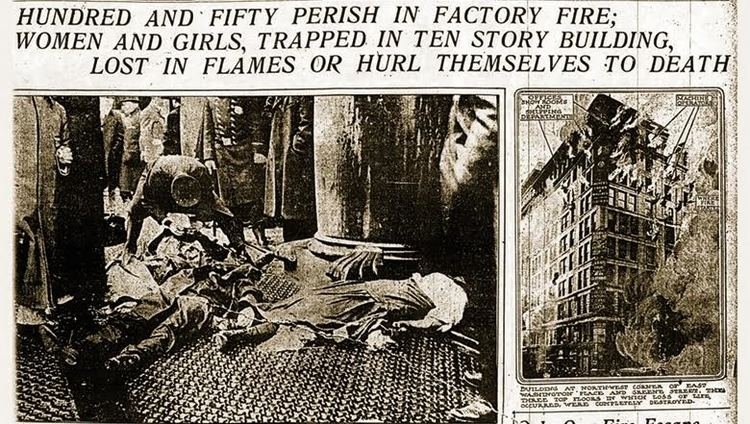
Introduction
On March 25, 1911, a fire broke out at the Triangle Shirtwaist Factory in New York City, killing 146 workers, mostly young immigrant women. The fire was one of the deadliest industrial disasters in American history, and it exposed the harsh and unsafe working conditions of the garment industry. The fire also sparked a wave of social and political reforms that improved the lives and rights of workers, women, and immigrants in America. And that is why we have chosen this title “The Triangle Shirtwaist Factory Fire: How a Tragedy Changed America” for our article
Table of Contents
1. The Fire

Triangle Factory Fire
The Triangle Shirtwaist Factory was located on the top three floors of the Asch Building, a 10-story structure near Washington Square Park in Manhattan. The factory produced women’s blouses, known as shirtwaists, which were popular at the time. The factory employed about 500 workers, who worked long hours for low wages, in a crowded and poorly ventilated space. The owners of the factory, Max Blanck and Isaac Harris, were notorious for their exploitative and oppressive practices, such as locking the doors to prevent workers from taking breaks or stealing, and hiring thugs to break up union meetings.
The fire started at around 4:40 pm, when a scrap bin under a cutting table on the eighth floor caught fire, possibly from a discarded cigarette. The fire quickly spread to the piles of flammable fabrics and wooden furniture. The workers on the eighth floor tried to escape, but found the doors locked or blocked by flames. Some managed to use the elevator or the stairs, while others used a telephone to alert the workers on the tenth floor, where the owners had their offices. The workers on the ninth floor, however, had no warning, and were trapped by the fire. The fire department arrived soon, but their ladders and hoses could not reach the upper floors. The workers had to choose between staying and burning, or jumping and falling. Many chose the latter, and their bodies piled up on the sidewalk, witnessed by horrified bystanders. The fire lasted for about half an hour, and by the time it was extinguished, 146 workers had died, 123 women and girls and 23 men. Most of the victims were Italian or Jewish immigrants, aged 14 to 23. The youngest were 14-year-olds Kate Leone and Rosaria “Sara” Maltese, and the oldest was 43-year-old Providenza Panno. The bodies of the victims were taken to a nearby pier, where thousands of people came to identify their relatives or friends. The next day, a mass funeral washeld for the unidentified victims, and over 100,000 people joined the procession, while another 250,000 lined the streets to pay their respects
2. The Aftermath
The fire shocked and outraged the public, and led to a demand for justice and reform. Blanck and Harris were put on trial for manslaughter, but were acquitted, as the prosecution could not prove that they knew the doors were locked. They were, however, found liable for wrongful death in a civil suit, and had to pay $75 per victim to their families, a fraction of what they received from their insurance company. The fire also inspired the labour movement, especially the International Ladies’ Garment Workers’ Union (ILGWU), which represented many of the Triangle workers. The union organized strikes and protests to demand better wages, hours, and working conditions for the garment workers. The fire also prompted the state and the city to enact new laws and regulations to improve the safety and health standards of factories, such as installing fire sprinklers, fire escapes, and alarms, and limiting the number of workers per floor. The fire also influenced the women’s suffrage movement, as many of the activists and organizers were women who had worked in the garment industry or witnessed the fire. The fire also raised awareness of the plight and potential of immigrants, who made up a large part of the workforce and the population of New York City.
3. The Legacy
The Triangle Shirtwaist Factory fire was a tragedy that changed America. It exposed the dark side of the industrial revolution and the urbanization of the country, and it inspired the social and political movements that shaped the progressive era. The fire also revealed the courage and resilience of the workers, who fought for their rights and dignity, and the compassion and solidarity of the public, who supported their cause. The fire also commemorated the lives and deaths of the victims, who became symbols of the struggle and the hope of the American dream.
FAQ
Q1 : What was the Triangle Shirtwaist Factory?
Ans: The Triangle Shirtwaist Factory was a garment factory in New York City that produced women’s blouses, known as shirtwaists. The factory employed about 500 workers, mostly young immigrant women, who workedlong hours for low wages, in a crowded and poorly ventilated space.
Q2: What caused the fire at the Triangle Shirtwaist Factory?
Ans: The fire started at around 4:40 pm on March 25, 1911, when a scrap bin under a cutting table on the eighth floor caught fire, possibly from a discarded cigarette. The fire quickly spread to the piles of flammable fabrics and wooden furniture. The workers tried to escape, but found the doors locked or blocked by flames.
Q3: How many people died in the fire?
Ans: The fire killed 146 workers, 123 women and girls and 23 men. Most of the victims were Italian or Jewish immigrants, aged 14 to 23. The youngest were 14-year-olds Kate Leone and Rosaria “Sara” Maltese, and the oldest was 43-year-old Providenza Panno.
